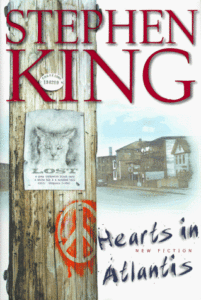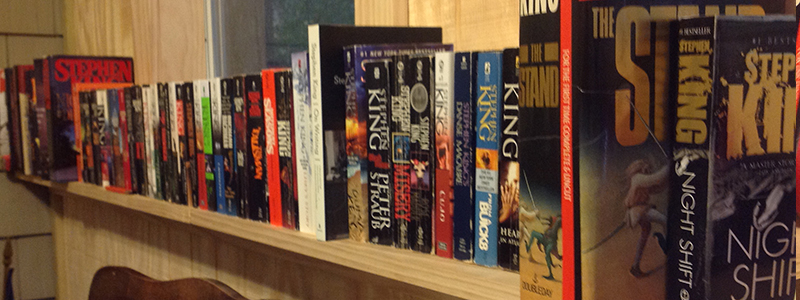by Jay Wilburn
The plan is to reread all of Stephen King’s works in the order that they were published. Richard Chizmar of Cemetery Dance had the vision. I’m doing it because I am a writer and I want to improve my fiction. And I love Stephen King’s stories. I think there is something to be learned through this process.
You can also go back to the beginning and read Before Carrie or any of my other posts up through this one and beyond by checking out this link to the Master List of all my #StephenKingRevisited posts.

I smell perfume still on my used copy of Hearts in Atlantis. It’s not mine, I swear. I’ve been calling it “Hearts of Atlantis” for years now.
This Ode to the 1960’s in the interconnected patchwork of stories and overlapping character connections may do as well a job as any of encapsulating that time.
Bicycles are a big part of any 1960s child’s life in a Stephen King story.
King “jumps heads” in the story. That is moving between the thoughts of multiple characters within a scene instead of sticking to one point-of-view character. I don’t have a problem with it as a reader, but editors do not let me get away with it as an author.
“If he had thought to mention the weird guys were wearing yellow coats, things might have gone much differently.” Pretty direct foreshadowing in what reads as a fine literary story through most of the first story in the book. The character’s story is just crazy enough for him to just be crazy with nothing supernatural going on it seems. Our character remembers books that have not yet been written on purpose for the story. Later, King cheats up the release of a television series a little bit before it came out in the real timeline
There are hints of “Apt Pupil” from Different Seasons in this narrative with the older man with a younger boy using reading newspapers to him as a cover for a lie to the parents about what is really going on.
There’s a little bit of “the shine” going on that afflicts magical characters and those who touch them in Stephen King stories. Bobby gets visions of the Tower holding the multi-verse together. Ted discusses Ka and the Tower, and guys on the other end of a phoneline reference The Crimson King.
The “library police” are mentioned.
“Clubbed together” has been used a lot for a phrase meaning gathering together or running together in the last three novels I’ve read by King.
“If the world had a plot, it would be much better.” Good line.
Watching for bullies parallels watching for agents of a higher evil, the low men.
As we move into the next story section of the composite novel, hearts becomes a card game that destroys lives. Kenny Austeer from Bag of Bones is playing hearts in college in 1966. Other characters from that novel are present for a time here as well. Boys become obsessed with the game, drop out, and end up in Vietnam.
King pulled out a solid second act in this novel. The spread of the adoption of the peace symbol is written well. Kids rise up out of confusion and then grow into adults. Carol’s life plays out in bits and pieces through the entire run of stories. She’s a bigger character than Bobby who was the big focus opening the novel.
In the third story, Bill goes from holding down girls for the other bullies to holding down his commute, holding together his mind post Vietnam, and trying to hold together multiple lives.
Bill decides the fat man next to him will stink by noon. He uses Carol as his fake wife’s name. He uses Bobby Garfield’s name, too. An ordinary commute translates into a much bigger mystery in the office.
Willie is haunted. John Sullivan was saved in Vietnam by a guy who was terrorizing him and the other little kids in the neighborhood. The dropouts ended up in Vietnam, too.
In the next story, John Sullivan goes to a funeral. Capitalism and his past shower down around him as he grapples with his sanity.
“Old women never hurt anyone as a rule. Old men are like rabid dogs.” Good line. Not sure it rings as true as other good lines from King, but a good line just the same.
They list off odd but common traits of Vietnam vets.
Carol learned to be “dim.” This is Stephen King’s conceit to the power of invisibility.
People shudder in bad novels, according to King.
On page 641, King gives his screed on what his generation actually did after Nam. A soft indictment of sorts.
“There was a time, don’t laugh, there was a time it was all in our hands.”
“Although it is difficult to believe, the 1960s were nonfiction. They actually happened.”
My next post in this series will be Before Storm of the Century which will be linked on the Master List of all my Stephen King Revisited posts.





